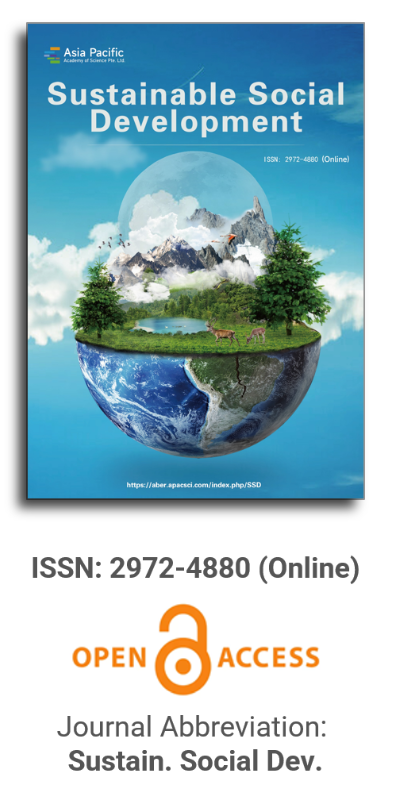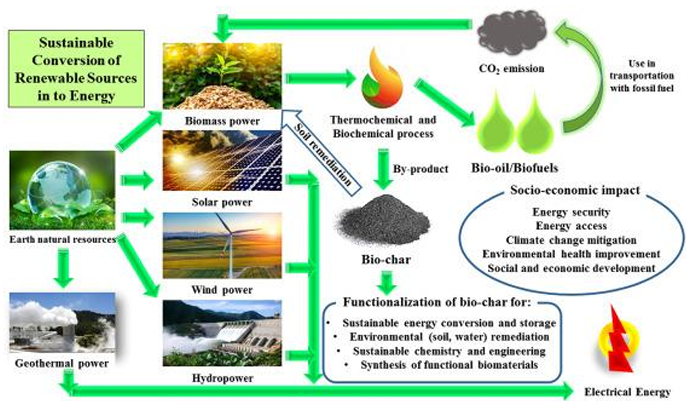
Asia Pacific Academy of Science Pte. Ltd. (APACSCI) specializes in international journal publishing. APACSCI adopts the open access publishing model and provides an important communication bridge for academic groups whose interest fields include engineering, technology, medicine, computer, mathematics, agriculture and forestry, and environment.

Evaluating the ecological consequences of heavy metal contamination in soil induced by spent engine oil and palm oil mill effluents for sustainable development
Vol 2, Issue 2, 2024
Download PDF
Abstract
This study assessed the ecological consequences of heavy metal contamination in soil induced by spent engine oil (SEO) and palm oil mill effluents (POME) in Ebonyi State, Nigeria. Concentrations of zinc, nickel, mercury, manganese, lead, iron, copper, chromium, and cadmium were analyzed across contaminated and uncontaminated sites. The research, conducted at Ebonyi State University’s Presco Campus, employed rigorous sampling and analytical methods. Results revealed that soil contaminated with spent engine oil effluent exhibited elevated mean concentrations of zinc, nickel, manganese, lead, iron, copper, chromium, and cadmium compared to the palm oil mill effluent and control sites. Conversely, mercury concentrations were higher in soil contaminated with palm oil mill effluent. Comparative analyses highlighted unique dynamics, such as lead concentrations being highest at the control site, challenging general trends observed for other metals. Importantly, none of the mean concentrations exceeded the WHO acceptable limits at the time of the study, indicating compliance with internationally recognized safety thresholds. The findings underscore the need for tailored environmental management strategies, considering specific contaminants associated with each effluent type. Continuous monitoring is crucial to ensure sustained adherence to safety standards and prevent potential future exceedances. This study contributes a valuable understanding of the nuanced ecological impact of industrial effluents on soil quality in Nigeria, emphasizing the importance of sustainable practices for environmental protection.
Keywords
References
- Ikhajiagbe B. Changes in Heavy Metal Contents of a Waste Engine Oil Polluted Soil Exposed to Soil pH Adjustments. British Biotechnology Journal. 2013, 3(2): 158-168. doi: 10.9734/bbj/2013/2374
- Ogwu C, Azonuche JE, Okumebo VO. Heavy metals content of Telfairiaoccidentalis (fluted pumpkin; order: Violales, Family: Cucurbitacea) grown in Ebedei (An oil and gas bearing community) Niger Delta, Nigeria. Quest Journals: Journal of Research in Humanities and Social Science. 2021, 9(4): 74-78.
- Kearns B, McDowell S, Moon J, et al. Distribution of contaminants in the environment and wildlife habitat use: a case study with lead and waterfowl on the Upper Texas Coast. Ecotoxicology. 2019, 28(7): 809-824. doi: 10.1007/s10646-019-02079-1
- Isaiah OO, Blessing AG. Environmental Pollutant of Palm Oil Effluent and Its Management in Okitipupa Area of Ondo State, Nigeria. Journal of Environment Protection and Sustainable Development. 2020, 6(4): 72-81.
- Ogunbileje JO, Sadagoparamanujam VM, Anetor JI, et al. Lead, mercury, cadmium, chromium, nickel, copper, zinc, calcium, iron, manganese and chromium (VI) levels in Nigeria and United States of America cement dust. Chemosphere. 2013, 90(11): 2743-2749. doi: 10.1016/j.chemosphere.2012.11.058
- Oriomah C, Adelowo OO, Adekanmbi AO. Bacteria from spent engine-oil-contaminated soils possess dual tolerance to hydrocarbon and heavy metals, and degrade spent oil in the presence of copper, lead, zinc and combinations thereof. Annals of Microbiology. 2014, 65(1): 207-215. doi: 10.1007/s13213-014-0851-x
- Asiamah JY, Otwe EP, Danquah A, et al. Effect of spilled engine oil on soil quality indicators and physiological performance of maize, cowpea and sorghum. African Journal of Environmental Science and Technology. 2021, 15(7): 262-269. doi: 10.5897/ajest2021.2999
- Salam LB, Obayori SO, Nwaokorie FO, et al. Metagenomic insights into effects of spent engine oil perturbation on the microbial community composition and function in a tropical agricultural soil. Environmental Science and Pollution Research. 2017, 24(8): 7139-7159. doi: 10.1007/s11356-017-8364-3
- Anerua FA, Azonuche JD. Information and communication technology (ICT): A necessary tool for food and nutrition education issues and challenges. Multidisciplinary Journal of Research Development. 2010, 14(4).
- Wang P, Chen H, Kopittke PM, et al. Cadmium contamination in agricultural soils of China and the impact on food safety. Environmental Pollution. 2019, 249: 1038-1048. doi: 10.1016/j.envpol.2019.03.063
- Alsherif EA, Al-Shaikh TM, AbdElgawad H. Heavy Metal Effects on Biodiversity and Stress Responses of Plants Inhabiting Contaminated Soil in Khulais, Saudi Arabia. Biology. 2022, 11(2): 164. doi: 10.3390/biology11020164
- Napoletano P, Guezgouz N, Di Iorio E, et al. Anthropic impact on soil heavy metal contamination in riparian ecosystems of northern Algeria. Chemosphere. 2023, 313: 137522. doi: 10.1016/j.chemosphere.2022.137522
- Panagopoulos T, González Duque JA, Bostenaru Dan M. Urban planning with respect to environmental quality and human well-being. Environmental Pollution. 2016, 208: 137-144. doi: 10.1016/j.envpol.2015.07.038
- Azonuche JE, Anyakoha EU. Construction criteria for functional apparel for caregivers in Day care centres in Delta State. Journal of Home Economics Research (JHER). 2018, 25(1): 1-12.
- Lee KH, Noh J, Khim JS. The Blue Economy and the United Nations’ sustainable development goals: Challenges and opportunities. Environment International. 2020, 137: 105528. doi: 10.1016/j.envint.2020.105528
- Peter AF. Spent engine oil and industrial effluent induced heavy metals and changes in soil and air potato quality. Soil and Environment. 2023, 42(1): 1-12. doi: 10.25252/se/2023/242838
- Ilyas M, Ahmad W, Khan H, et al. Environmental and health impacts of industrial wastewater effluents in Pakistan: a review. Reviews on Environmental Health. 2019, 34(2): 171-186. doi: 10.1515/reveh-2018-0078
- Golia EE. The impact of heavy metal contamination on soil quality and plant nutrition. Sustainable management of moderate contaminated agricultural and urban soils, using low cost materials and promoting circular economy. Sustainable Chemistry and Pharmacy. 2023, 33: 101046. doi: 10.1016/j.scp.2023.101046
- Long Z, Huang Y, Zhang W, et al. Effect of different industrial activities on soil heavy metal pollution, ecological risk, and health risk. Environmental Monitoring and Assessment. 2021, 193(1). doi: 10.1007/s10661-020-08807-z
- Pushpanjali, Sharma KL, Venkanna K, et al. Industrial pollution and soil quality—A case study from industrial area, Visakhapatnam, Andhra Pradesh, India. In: Mishra RK, Kumari CL, Chachra S (editors). Smart Cities for Sustainable Development. Springer; 2022. pp. 327-334. doi: 10.1007/978-981-16-7410-5_20
- Lai RWS, Kang HM, Zhou GJ, et al. Hydrophobic Surface Coating Can Reduce Toxicity of Zinc Oxide Nanoparticles to the Marine Copepod Tigriopus japonicus. Environmental Science & Technology. 2021, 55(10): 6917-6925. doi: 10.1021/acs.est.1c01300
- Hu HW, Wang JT, Li J, et al. Long-Term Nickel Contamination Increases the Occurrence of Antibiotic Resistance Genes in Agricultural Soils. Environmental Science & Technology. 2016, 51(2): 790-800. doi: 10.1021/acs.est.6b03383
- Khademi H, Gabarrón M, Abbaspour A, et al. Environmental impact assessment of industrial activities on heavy metals distribution in street dust and soil. Chemosphere. 2019, 217: 695-705. doi: 10.1016/j.chemosphere.2018.11.045
- Beardsley CA, Fuller KZ, Reilly TH, et al. Method for analysis of environmental lead contamination in soils. The Analyst. 2021, 146(24): 7520-7527. doi: 10.1039/d1an01744f
- Dhal B, Thatoi HN, Das NN, et al. Chemical and microbial remediation of hexavalent chromium from contaminated soil and mining/metallurgical solid waste: A review. Journal of Hazardous Materials. 2013, 250-251: 272-291. doi: 10.1016/j.jhazmat.2013.01.048
- Obasi PN, Akudinobi BEB. Heavy metals occurrence, assessment and distribution in water resources of the lead–zinc mining areas of Abakaliki, Southeastern Nigeria. International Journal of Environmental Science and Technology. 2019, 16(12): 8617-8638. doi: 10.1007/s13762-019-02489-y
- Emmanuel E, Sombo T, Ugwanyi J. Assessment of Heavy Metals Concentration in Shore Sediments from the Bank of River Benue, North-Central Nigeria. Journal of Geoscience and Environment Protection. 2018, 6(4): 35-48. doi: 10.4236/gep.2018.64003
Supporting Agencies
Copyright (c) 2024 Tobechukwu Ebele Okeke, Sylvanus Chima Ewuim, Cosmas Augustus Uhuo, Benjamin Uzonna Ononye, Chidi Emmanuel Akunne, Kasarachi Patricia Okafor
License URL: https://creativecommons.org/licenses/by/4.0

This site is licensed under a Creative Commons Attribution 4.0 International License (CC BY 4.0).

Prof. Kittisak Jermsittiparsert
University of City Island, Cyprus






It is with deep regret that we announce the cancellation of the Forum on Sustainable Social Development & Computing and Artificial Intelligence, originally scheduled for June 15, 2025.

